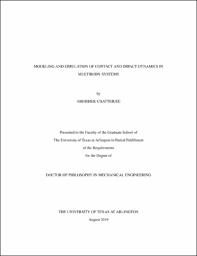
ATTENTION: The works hosted here are being migrated to a new repository that will consolidate resources, improve discoverability, and better show UTA's research impact on the global community. We will update authors as the migration progresses. Please see MavMatrix for more information.
Show simple item record
| dc.contributor.advisor | Bowling, Alan P. | |
| dc.creator | Chatterjee, Abhishek | |
| dc.date.accessioned | 2019-08-27T16:47:18Z | |
| dc.date.available | 2019-08-27T16:47:18Z | |
| dc.date.created | 2019-08 | |
| dc.date.issued | 2019-08-12 | |
| dc.date.submitted | August 2019 | |
| dc.identifier.uri | http://hdl.handle.net/10106/28575 | |
| dc.description.abstract | Contact and impact analyses are an essential part of multibody dynamic simulations. Modeling of contact and impact problems have applications in a wide variety of areas including robotics, earthquake engineering, computer graphics, and manufacturing. Collisions between objects typically take place over surfaces that are represented by a set of points in the operation space, thereby requiring multi-point contact and impact analysis. Analysis of multi-point contact and impact may lead to indeterminate (underdetermined) problems with more number of unknowns (contact forces) than equations.
This work pertains to the problem of resolving multi-point contact and impact problems in multibody systems consisting of hard objects, that can be assumed to be rigid. In the first part of this work, a rigidity based modeling and simulation technique is developed for multi-point impacts between hard objects. In this proposed framework impacts are treated as discrete events during which the velocities of the system evolve in the impulse-domain, based on an impulse-momentum theory called {\em Darboux-Keller} shock. Constraints derived based on the rigid body assumption are used to resolve indeterminacy associated with multi-point analysis. An energetic terminal constraint is also proposed based on {\em Stronge's Hypothesis}, that guarantees the treatment of impact to be energetically consistent. This approach is used to derive both planar and three-dimensional models of multi-point indeterminate impacts.
The rigid impact model based on impulse-momentum theory, developed in the first part of this work, loses some information like force and deformation histories during impacts. This lost information, however can be useful in certain types of application. Hence, to retain this information, the second part of this work proposes a method of augmenting the rigid-impact model with a contact force model from the contact mechanics literature to simultaneously determine the force and deformation histories during an impact event. The contact force model used here is a viscoelastoplastic model of contact
that considers the effects of permanent (plastic) deformation in the material. A relationship is developed between the permanent deformations of the material and the energetic terminal constraint proposed in the first part of this work to characterize the force histories during collisions.
The accumulation of discrete impact events during the time-domain simulation may lead to chattering or zeno phenomenon, causing the adaptive step-size integration to halt or fail. This work resolves this problem by transitioning to contact when the normal components of the post-impact velocities become very small. During contact, the forces between the participating rigid bodies satisfy the: 1) non-penetrability condition and 2) frictional force constraints based on Coulomb Friction. The non-penetrability condition enforces normal velocity and acceleration constraints on the equations of motion, whereas the Coulomb friction constrains the tangential forces at the contact points. These constraints placed on the equations of motion, lead to a reduction in the number of degrees of freedom (DOF) of the system. This work uses an online constraint embedding technique to enforce contact constraints. | |
| dc.format.mimetype | application/pdf | |
| dc.language.iso | en_US | |
| dc.subject | Multibody dynamics | |
| dc.subject | Contact | |
| dc.subject | Impact | |
| dc.subject | Stick-slip transition | |
| dc.subject | Online constraint embedding | |
| dc.subject | Coordinate partitioning | |
| dc.subject | Coordinate reduction | |
| dc.subject | Deformation | |
| dc.subject | Impact forces | |
| dc.subject | Time of impact | |
| dc.title | MODELING AND SIMULATION OF CONTACT AND IMPACT DYNAMICS IN MULTIBODY SYSTEMS | |
| dc.type | Thesis | |
| dc.degree.department | Mechanical and Aerospace Engineering | |
| dc.degree.name | Doctor of Philosophy in Mechanical Engineering | |
| dc.date.updated | 2019-08-27T16:48:23Z | |
| thesis.degree.department | Mechanical and Aerospace Engineering | |
| thesis.degree.grantor | The University of Texas at Arlington | |
| thesis.degree.level | Doctoral | |
| thesis.degree.name | Doctor of Philosophy in Mechanical Engineering | |
| dc.type.material | text | |
| dc.creator.orcid | 0000-0002-7297-941X | |
Files in this item
- Name:
- CHATTERJEE-DISSERTATION-2019.pdf
- Size:
- 4.425Mb
- Format:
- PDF
This item appears in the following Collection(s)
Show simple item record


